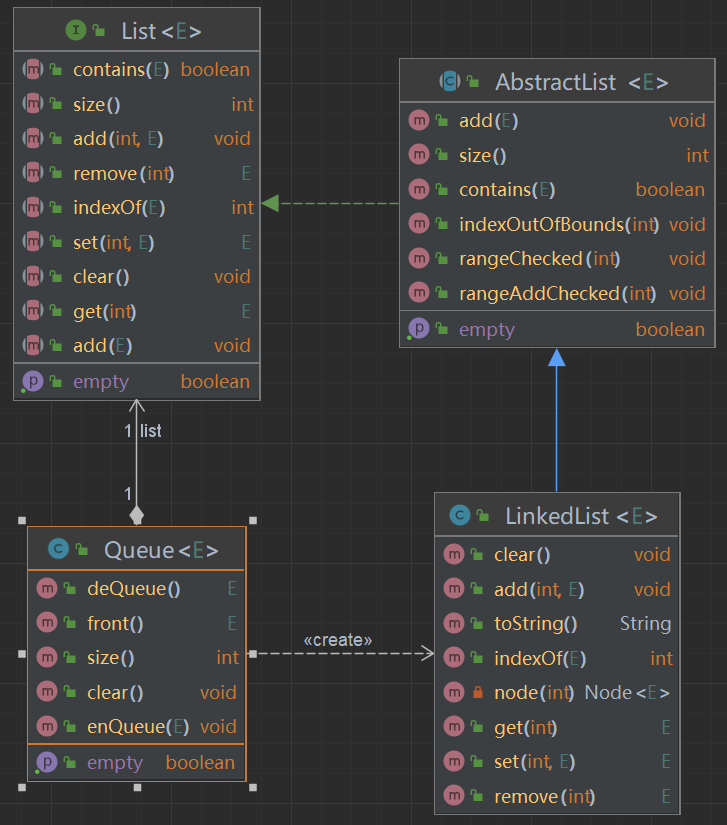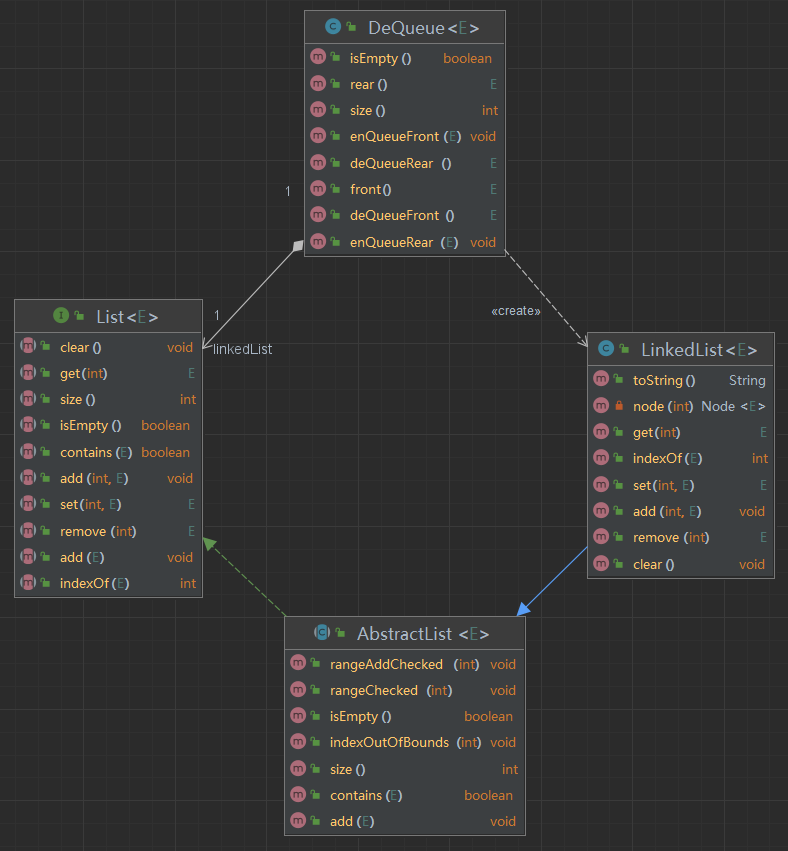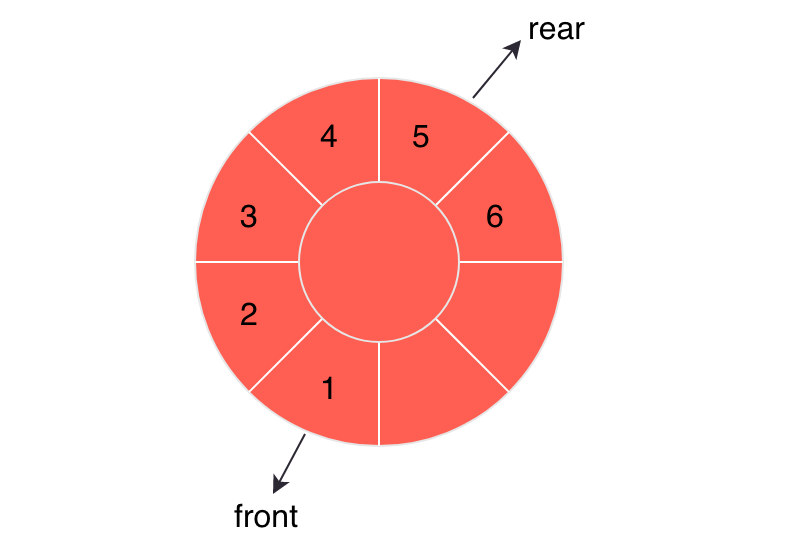1. 内容大纲
本章节的代码:https://github.com/wicksonZhang/data-structure/tree/main/4-Queue
2. 基础知识2.1. 什么是队列队列:是一种线性表的数据结构,队列有头尾两端,分别是队头和队尾。元素会先从对头进行入队,再从队尾进行出队。遵循 First In First Our 原则。
2.2. 队列的优缺点优点
开发简单: 队列主要是基于链表或者动态数组,所以开发简单易懂。FIFO原则: 队列遵循先进先出原则,保证了数据处理的顺序性和稳定性。代码解耦: 例如我们平时常见的消息队列其实底层采用的数据结构就是队列,而消息队列的最大一个特点就是解耦。
缺点
不支持随机访问: 由于队列基于链表,所以也导致了队列不支持随机访问。
2.3. 队列的分类
普通队列(Basic Queue): 这是最基本的队列形式,按照先进先出(FIFO)的原则管理数据。双端队列(Deque): 双端队列支持在队列的两端进行插入和删除操作。可以从前端或后端插入/删除元素,具有更灵活的操作特性。循环队列(Circular Queue): 循环队列是一种特殊类型的队列,在队列的基础上做了优化,通过循环利用数组空间来避免数组元素移动的开销。
2.4. 生活中对应的场景
排队场景:例如我们平时排队,遵循的就是 FIFO 原则。
水管:我们平时用的水管也是遵循 FIFO 原则。
3. 普通队列3.1. 接口设计
我们的普通队列主要是基于链表进行实现,所以还是要基于以前的代码。
1 2 3 4 5 6 7 8 9 10 11 12 13 14 15 16 17 18 19 20 21 22 23 24 25 public class Queue <E> { private List<E> list = new LinkedList <>(); public int size () {} public boolean isEmpty () {} public void enQueue (E element) {} public E deQueue () {} public E front () {} }
3.2. 代码实现3.2.1. 初始化成员变量1 private List<E> list = new LinkedList <>();
3.2.2. 元素的数量1 2 3 4 5 6 7 8 public int size () { return list.size(); }
3.2.3. 是否为空1 2 3 4 5 6 7 8 public boolean isEmpty () { return list.isEmpty(); }
3.2.4. 清空元素1 2 3 4 5 6 public void clear () { list.clear(); }
3.2.5. 入队
1 2 3 4 5 6 7 8 public void enQueue (E element) { list.add(element); }
3.2.6. 出队
1 2 3 4 5 6 7 8 public E deQueue () { return list.remove(0 ); }
3.2.7. 获取队列的头元素1 2 3 4 5 6 7 8 public E front () { return list.get(0 ); }
3.3. 单元测试1 2 3 4 5 6 7 8 9 10 11 12 13 14 15 16 17 18 19 20 21 22 23 24 25 26 27 28 29 30 31 32 33 34 35 36 37 public class BaseQueueTest { private BaseQueue<Integer> queue; @BeforeEach public void setup () { queue = new BaseQueue <>(); } @Test public void testEnqueueAndSize () { queue.enQueue(5 ); queue.enQueue(10 ); Assertions.assertEquals(2 , queue.size()); } @Test public void testDequeueAndFront () { queue.enQueue(5 ); queue.enQueue(10 ); Assertions.assertEquals(5 , queue.front()); Assertions.assertEquals(5 , queue.deQueue()); Assertions.assertEquals(1 , queue.size()); Assertions.assertEquals(10 , queue.front()); } @Test public void testIsEmptyAndClear () { Assertions.assertTrue(queue.isEmpty()); queue.enQueue(5 ); queue.enQueue(10 ); Assertions.assertFalse(queue.isEmpty()); queue.clear(); Assertions.assertTrue(queue.isEmpty()); } }
3.4. 实战练习3.4.1. 用栈实现队列
232. 用栈实现队列 - 力扣(LeetCode)
需求
实现思路
首先,准备两个栈。inStack、outStack
然后,入队时,将元素放入 inStack 栈中。
最后,出队(pop) 和获取栈顶元素(peek) 时,需要考虑如下两个问题:
outStack 为空:直接将 inStack 栈中的所有元素 push 到 outStack ,然后再从 outStack 弹出。outStack 不为空:直接将 outStack 中的元素弹出。
实现代码
1 2 3 4 5 6 7 8 9 10 11 12 13 14 15 16 17 18 19 20 21 22 23 24 25 26 27 28 29 30 31 32 33 34 35 36 37 class MyQueue { private Stack<Integer> inStack; private Stack<Integer> outStack; public MyQueue () { inStack = new Stack <>(); outStack = new Stack <>(); } public void push (Integer x) { inStack.push(x); } public int pop () { if (outStack.isEmpty()) { while (!inStack.isEmpty()) { outStack.push(inStack.pop()); } } return outStack.pop(); } public int peek () { if (outStack.isEmpty()) { while (!inStack.isEmpty()) { outStack.push(inStack.pop()); } } return outStack.peek(); } public boolean empty () { return inStack.isEmpty() && outStack.isEmpty(); } }
4. 双端队列
双端队列本质上也是队列的一种,本质意思就是元素可以从队头和队尾进行入队和出队。
4.1. 接口设计
我们的普通队列主要是基于链表进行实现,所以还是要基于以前的代码。
1 2 3 4 5 6 7 8 9 10 11 12 13 14 15 16 17 18 19 20 21 22 23 24 25 26 27 28 29 30 31 32 public class DeQueue <E> { private LinkedList<E> linkedList = new LinkedList <>(); public int size () {} public boolean isEmpty () {} public void enQueueRear (E element) {} public E deQueueRear () {} public void enQueueFront (E element) {} public E deQueueFront () {} public E front () {} public E rear () {} }
4.2. 代码实现4.2.1. 初始化成员变量1 private List<E> linkedList = new LinkedList <>();
4.2.2. 元素的数量1 2 3 4 5 6 7 public int size () { return linkedList.size(); }
4.2.3. 是否为空1 2 3 4 5 6 7 public boolean isEmpty () { return linkedList.isEmpty(); }
4.2.4. 从队尾入队1 2 3 4 5 6 7 8 public E deQueueRear () { return linkedList.remove(size() - 1 ); }
4.2.5. 从队头入队1 2 3 4 5 6 7 8 public E deQueueFront () { return linkedList.remove(0 ); }
4.2.6. 获取队列的头元素1 2 3 4 5 6 7 8 public E front () { return linkedList.get(0 ); }
4.2.7. 获取队列的尾元素1 2 3 4 5 6 7 8 public E rear () { return linkedList.get(size() - 1 ); }
4.3. 单元测试1 2 3 4 5 6 7 8 9 10 11 12 13 14 15 16 17 18 19 20 21 22 23 24 25 26 27 28 29 30 31 32 33 34 35 36 37 38 39 40 41 42 43 44 45 46 47 48 49 50 51 52 53 54 55 56 57 58 59 60 61 public class DeQueueTest { @Test public void testEmptyQueue () { DeQueue<Integer> queue = new DeQueue <>(); assertEquals(0 , queue.size()); assertTrue(queue.isEmpty()); assertThrows(IndexOutOfBoundsException.class, queue::deQueueFront); assertThrows(IndexOutOfBoundsException.class, queue::deQueueRear); } @Test public void testEnqueueDequeue () { DeQueue<String> queue = new DeQueue <>(); queue.enQueueRear("First" ); queue.enQueueFront("New First" ); assertEquals(2 , queue.size()); assertFalse(queue.isEmpty()); assertEquals("New First" , queue.deQueueFront()); assertEquals("First" , queue.deQueueRear()); assertTrue(queue.isEmpty()); } @Test public void testFrontRear () { DeQueue<Character> queue = new DeQueue <>(); queue.enQueueRear('A' ); queue.enQueueRear('B' ); queue.enQueueFront('C' ); queue.enQueueFront('D' ); assertEquals('D' , queue.front()); assertEquals('B' , queue.rear()); } @Test public void testBoundaryConditions () { DeQueue<Integer> queue = new DeQueue <>(); queue.enQueueRear(42 ); assertEquals(42 , (int ) queue.deQueueFront()); assertTrue(queue.isEmpty()); for (int i = 0 ; i < 1000 ; i++) { queue.enQueueRear(i); } for (int i = 0 ; i < 1000 ; i++) { assertEquals(i, (int ) queue.deQueueFront()); } assertTrue(queue.isEmpty()); } }
5. 循环队列
循环队列 :就是将队列存储空间的最后一个位置绕到第一个位置,形成逻辑上的环状空间,供队列循环使用。
底层可以通过数组进行扩容,实现数据的入队和出队,元素从 rear 指向的位置入队,front 指向的位置出队。
5.1. 接口设计
目前我们通过动态数组实现循环队列
1 2 3 4 5 6 7 8 9 10 11 12 13 14 15 16 17 18 19 20 21 22 23 24 25 26 27 28 29 30 31 public class CircleQueue <E> { private int front; private int size; private E[] elements; public int size () {} public boolean isEmpty () {} public void enQueue (E element) {} public E deQueue () {} public E front () {} }
5.2. 代码实现5.2.1. 初始化成员变量1 2 3 4 5 6 7 8 9 10 11 12 13 14 15 16 17 18 19 20 21 @SuppressWarnings("unchecked") public class CircleQueue <E> { private int size; private int front; private E[] elements; private static final int DEFAULT_CAPACITY = 10 ; public CircleQueue () { this .elements = (E[]) new Object [DEFAULT_CAPACITY]; } }
5.2.2. 元素的数量
与数组保持一致
1 2 3 4 5 6 7 8 public int size () { return size; }
5.2.3. 队列是否为空1 2 3 4 5 6 7 8 public boolean isEmpty () { return size == 0 ; }
5.2.4. 入队
入队:入队的其实就是往最后一个元素添加元素,由于我们时循环链表,需要考虑的问题就比较多了。
问题一:如果是在最后一个位置进行入队,那么元素应该需要添加到队列的第一个元素。
问题二:由于动态数组的默认容量是 10 , 当队列满了的时候就需要考虑扩容了。
1 2 3 4 5 6 7 8 9 10 11 12 public void enQueue (E element) { ensureCapacity(size + 1 ); elements[index(size)] = element; size++; }
5.2.4.1. 获取下一个元素的索引
这个是对动态数组到了最后一个元素时,在添加元素时就需要获取当前元素的索引
1 2 3 4 5 6 7 8 9 10 11 12 private int index (int index) { index += front; return index - (elements.length > index ? 0 : elements.length); }
5.2.4.2. 数组扩容
当数组的容量满了之后就需要进行扩容。
1 2 3 4 5 6 7 8 9 10 11 12 13 14 15 16 17 @SuppressWarnings("unchecked") private void ensureCapacity (int capacity) { if (capacity - elements.length > 0 ) { int newCapacity = capacity + (capacity >> 1 ); E[] newElement = (E[]) new Object [newCapacity]; for (int i = 0 ; i < size; i++) { newElement[i] = elements[index(i)]; } elements = newElement; front = 0 ; } }
5.2.5. 出队
出队是比较简单的,我们只需要将 front 索引指向的元素弹出即可。
1 2 3 4 5 6 7 8 9 10 11 12 13 14 15 public E deQueue () { if (size <= 0 ) { throw new IndexOutOfBoundsException ("This Circle is null" ); } E element = elements[front]; elements[front] = null ; front = index(1 ); size--; return element; }
5.2.6. 获取队列的头元素
front 指向的元素就是头元素
1 2 3 4 5 6 7 8 9 public E front () { if (size <= 0 ) { throw new IndexOutOfBoundsException ("This Circle is null" ); } return elements[front]; }
5.3. 单元测试1 2 3 4 5 6 7 8 9 10 11 12 13 14 15 16 17 18 19 20 21 22 23 24 25 26 27 28 29 30 31 32 33 34 35 36 37 38 39 40 41 42 43 44 45 46 47 48 49 50 51 52 53 54 55 56 57 58 59 public class CircleQueueTest { @Test public void testEmptyQueue () { CircleQueue<Integer> queue = new CircleQueue <>(); assertTrue(queue.isEmpty()); assertEquals(0 , queue.size()); assertThrows(IndexOutOfBoundsException.class, queue::deQueue); assertThrows(IndexOutOfBoundsException.class, queue::front); System.out.println("queue = " + queue); } @Test public void testEnqueueAndDequeue () { CircleQueue<String> queue = new CircleQueue <>(); queue.enQueue("One" ); queue.enQueue("Two" ); queue.enQueue("Three" ); assertEquals(3 , queue.size()); assertFalse(queue.isEmpty()); assertEquals("One" , queue.front()); assertEquals("One" , queue.deQueue()); assertEquals("Two" , queue.deQueue()); assertEquals("Three" , queue.deQueue()); assertTrue(queue.isEmpty()); assertEquals(0 , queue.size()); assertThrows(IndexOutOfBoundsException.class, queue::deQueue); assertThrows(IndexOutOfBoundsException.class, queue::front); System.out.println("queue = " + queue); } @Test public void testQueueResize () { CircleQueue<Integer> queue = new CircleQueue <>(); int initialCapacity = 20 ; for (int i = 0 ; i < initialCapacity; i++) { queue.enQueue(i); } System.out.println("queue = " + queue); assertEquals(initialCapacity, queue.size()); for (int i = 0 ; i < initialCapacity; i++) { assertEquals(i, queue.deQueue()); } System.out.println("queue = " + queue); assertTrue(queue.isEmpty()); assertEquals(0 , queue.size()); } }
6. 参考博文

















